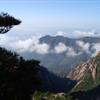China takes up most of East Asia with its enormous expanse of land bordering Russia and Mongolia in the north, Korea in the east, Vietnam, Myanmar, India, Laos, Nepal and Bhutan in the south and Pakistan, Afghanistan, Tajikistan, Kyrgyzstan and Kazakhstan in the west. The official language is Mandarin Chinese as well as an enormous number of local dialects, and Beiijing is China’s capital, even here it is not easy to find someone who speaks English, only tourist guides do.
The country is so large its landscape varies greatly from the flatlands in the east the high plateaus in the west and the mountains, which cover almost two thirds of the country. The Himalayas are the most well-known rising over 8,000 meters above sea level, other ranges include the Altai Mountains, the Tian Shan Mountains and the Kunlun Mountains, here the more daring of climbers face the famous Mount Everest (8,848m).
China boasts thirty seven UNESCO World Heritage sites amongst which are the Forbidden City in Beijing, the Great Wall, Xi’an’s Terracotta Army, the peaks of Huangshan and the Suzhou gardens. Chinese culture and traditions go way back in the past, it is in fact one of the earliest world’s civilizations with its numerous succeeding Dynasties. The country is a chest of cultural, architectural and historical riches, not to mention its cuisine famous worldwide.
Sites to visit are Beijing with its blend of futuristic monuments and ancient buildings, Shanghai, the heights of Tibet, the rivers of Guizhou amongst many other sites of historical and natural beauty.
The climate in China varies considerably depending on the areas, from extremely hot and arid temperatures to biting cold winters. There are areas with tropical climates and many regions are subject to seismic activity.



























